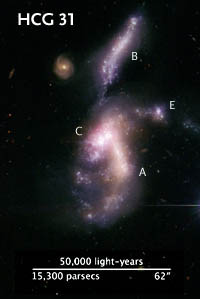The Big Bang left matter in the infant universe closely packed together — overcrowding that in time forced countless small galaxies to merge into huge ones. Peering deeply across time and space, astronomers are getting better at glimpsing these early assemblies. But the distances to them are so vast that it's difficult to discern exactly how the mergers took place — crucial details needed to understand how galaxies evolve.

Cosmic fireworks are occurring 166 million light-years away in Eridanus, where an ancient cluster of small galaxies designated Hickson Compact Group 31 is merging into one large object. Click on the image for a larger view.
NASA / ESA / S. Gallagher / J. English
Fortunately, observers have locked onto a galactic get-together that's happening relatively nearby, only 166 million light-years away in the constellation Eridanus. It's remarkable that this ancient cluster of small, irregular galaxies has survived for some 10 billion years only to be combining now, especially because they're moving slowly with respect to one another (only about 60 km per second).
Four members of the Hickson Compact Group 31 (and also known as NGC 1471), are coming together in a space about 75,000 light-years across — less than the diameter of the much larger Milky Way. "They each have a mass about one-tenth of the Milky Way," says Sarah Gallagher (University of Western Ontario), "so they're on the high-mass side of what would be called dwarf galaxies." Two components, A and C, are the brightest of the bunch. They have a visual magnitude of 13½, putting them within the grasp of a large amateur telescope.
"Because HCG 31 is so nearby," she notes, "we can identify individual star clusters. We could never do a study like this if it were much farther away."
Another piece of HCG 31, component F, is a fresh addition to the cluster, having formed along the tail that extends southeast from A and C toward component G. "We looked quite hard and couldn't find any evidence for old stars in it," Gallagher says. Chances are good that it started forming stars only within the last 10 million years.
(As for the missing letters of the alphabet, component D is a background galaxy that is not a part of the group, and E is a tidal castoff that unites A, C, and G.)
Astronomers have suspected for more than a decade that HGC 31 has been merging. Hydrogen gas permeates the entire group, providing the fuel for localized bursts of star formation in disturbed sections. "The velocities of the gas are messed up (not nicely organized as in a quieter environment)," says Gallagher. This signals that a merger is happening — as all the components come together, the resulting gravity pulls the gas in different directions. The team estimates that the reserves of hydrogen will be used up quickly — within 1 billion years — given how rapidly stars are being born right now, with the likely final outcome a single elliptical galaxy.
Gallagher led a team of 15 researchers who combined observations from the Hubble Space Telescope (visible light), Spitzer Space Telescope (infrared), and both Swift and Galex (ultraviolet). Their study is being published in the February 2010 issue of Astronomical Journal. You can read a press release about their effort here.
Julie Freydlin is a freelance science writer based in New Jersey.
 0
0
Comments
You must be logged in to post a comment.